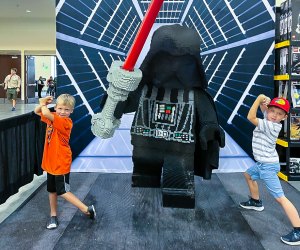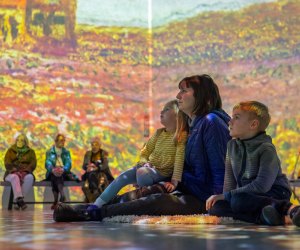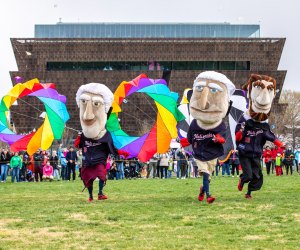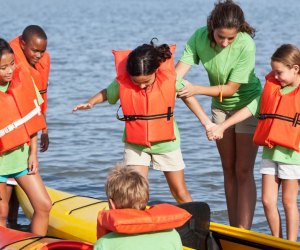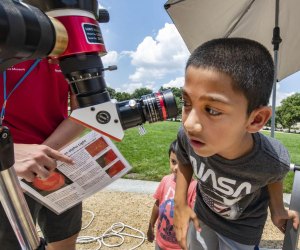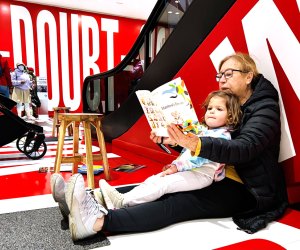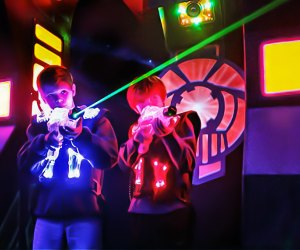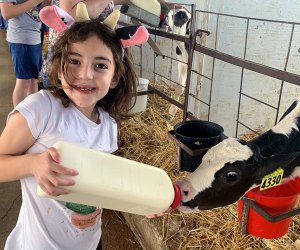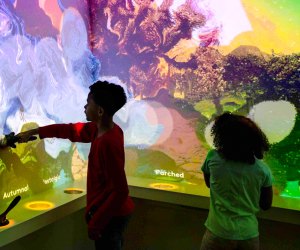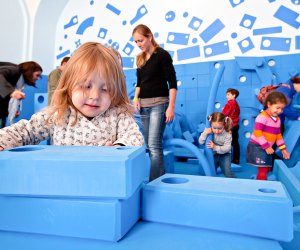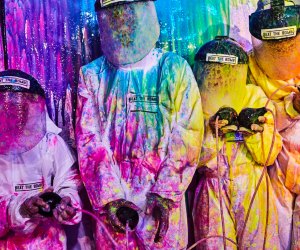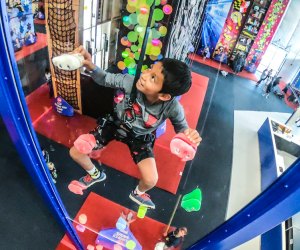Visiting Smithsonian's National Air and Space Museum in DC with Kids
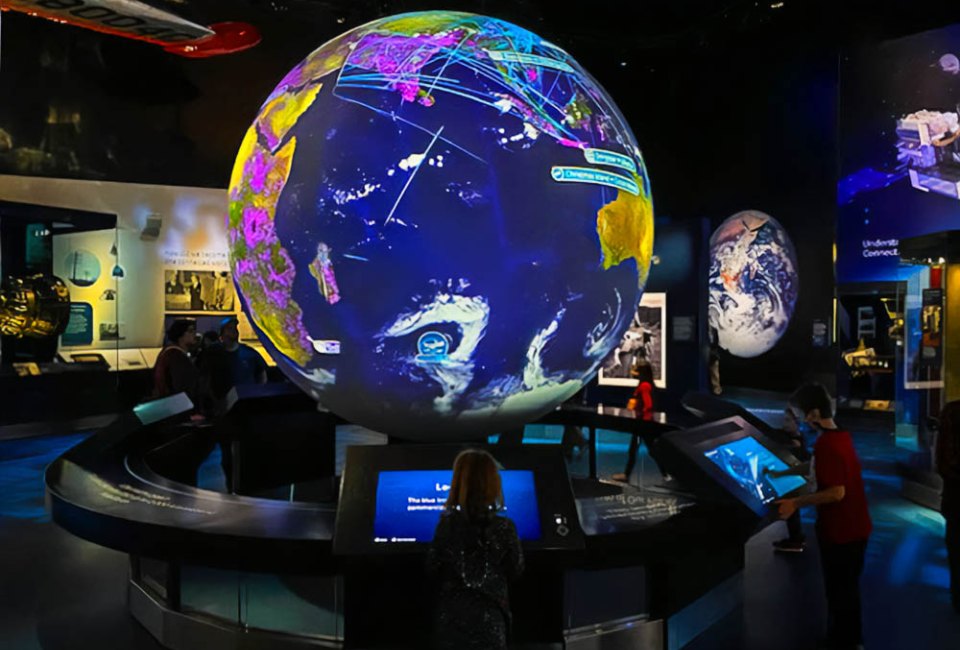
Smithsonian's National Air and Space Museum has been one of our family’s favorite spots to visit in Washington, DC since our son was 2, when he decided he wants to be an astronaut. The museum houses one of the world’s premier collections of flight and space-related artifacts and history. It closed down for a period in 2018 as it undergoes a monumental, multiyear renovation, but reopened in late 2022 with eight of the planned 23 exhibits completely redone.
We were excited to go back and bring our newest family member (now 2) to the museum. While we were a bit disappointed that so much of the museum was still closed, our children really enjoyed the redesigned exhibits. And the best part is, like all Smithsonian museums, it's completely FREE!
Read on for a peek into what to expect when visiting Smithsonian's National Air and Space Museum. Then check out our DC Museum Guide for more great museums to visit with kids, including our lists of free museums near DC and the best museums for kids in the DC area.
OUR LATEST VIDEOS
Note: We will update this post as new exhibits and sections of the museum reopen.
National Air and Space Museum Exhibits
1. Early Flight
This large exhibit, which will excite history buffs, explores the hottest decade in flight discovery from 1903, when the Wright brothers had their pioneering flight, to 1914 when World War I broke out. You can see artifacts like the Lilienthal Glider—the first successful, full-sized glider (imagine a human with huge bat wings)—and the Blériot Type XI, the first airplane to cross the English Channel.
RELATED: Visiting Smithsonian's National Museum of African American History and Culture in DC with Kids
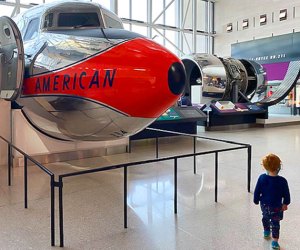
It was hard to drag our daughter away from the old American Airways Douglas DC-7 airplane. Photo by the author
2. America by Air
Tracing the development of commercial flight in America, this very impressive exhibit is mostly hanging from the ceiling of the museum, so look up! It also contains our 2-year old’s favorite part of the museum, the old American Airways Douglas DC-7 airplane that she could actually enter and walk down the aisle to explore the cockpit, the bathroom, and the seating area. As a side note, I personally found how pilots used to navigate using a scrolling map a little terrifying.
3. Destination Moon
Another one of the kids’ favorites, this exhibit details the decade-long journey from the first machine landing on the moon to the first humans walking on the moon. You can feast your eyes on the Apollo 11 command module, Columbia, which is claustrophobically small, and Neil Armstrong’s Apollo 11 voyage space suit. Getting to see these exciting artifacts in this exhibit really makes the dream destination a reality.
4. Nation of Speed
This exhibit is smaller and, to me, felt a little out of place in an air and space museum. Features I noticed were a stuffed lion, an early motorcycle, a winning race car from an Indy 500 race, and a rocket sled. The focus is on how new technology keeps getting faster and faster and how America’s need for speed has affected out national identity.
5. The Wright Brothers and the Invention of the Aerial Age
This exhibit provides a detailed account of one of America’s greatest success stories, the invention of the airplane by Wilbur and Orville Wright in 1903. In this exhibit you can see one of the most iconic artifacts in the museum, the Wright Flyer. This room did not excite our kids (ages 2, 5, and 7) all that much, but it is impressive to think about how these brothers changed the course of history with their invention. I mean, most of the other exhibits in this museum were only possible because of them!
6. Kenneth C. Griffin Exploring the Planets
This was one of our kids’ favorites of the new exhibits. It explores the planets and moons to show how understanding our solar system can help us to understand Earth better. The kids thoroughly enjoyed the walk-in, wraparound theater showing what the environmental would be like on different bodies (i.e. asteroids, planets, moons) in our solar system. We were excited by the model of the Mars rover, Curiosity, and the test model of the famous Voyager spacecraft. And Trekkies can find Spock’s ears on display!
7. Thomas W. Haas We All Fly
The kids enjoyed running around and seeing all the different aircraft in this exhibit, some of which are quite unique and interesting-looking. One is the Common Phase II, which resembles a tricycle with futuristic wings and a large wind turbine on the back. Another is the Fulton Airphibian, an aircraft you could fly to the airport, then disengage the wings and drive it like a car the rest of the way to your destination. Also on display is one of the first helicopters, which to me looked quite small.
8. One World Connected
This exhibit focuses on using the sky for communication. It contains an interactive recreation of the Cupola Observatory on the International Space Station (ISS), which is 250 miles above the planet’s surface. Kids can see the Earth the way astronauts on the ISS see it, and the views of Earth from different angles are spectacular. The most surprising thing I learned was that from up there, they see the sun rise every 90 minutes. Look up while in the exhibit to see different satellites that have allowed mobile phone calls and communication in space. And the kids really liked the large, interactive globe!
Know Before You Go to the National Air and Space Museum
Visiting the National Air and Space Museum
The museum is open every day except Christmas Day from 10am-5:30pm. To visit, you must reserve free timed-entry passes online. Passes are released periodically in six-week blocks, and additional same-day passes are released daily at 8:30am and on Fridays through Mondays at 12:30pm. You can reserve six free tickets per visit. If you need more, have another person reserve them, or reserve group passes for 10 people or more.
Everyone, no matter their age, must have a pass. Keep in mind that there is no re-entry.
I suggest getting to the museum as early as possible for fewer crowds. We arrived at 10am when it opened, and by noon the line was long even with the timed passes.
Location
The National Air and Space Museum is located on the National Mall along with many other spectacular museums, the DC monuments, and the National Arboretum, all of which are FREE.
Parking
There is paid street parking around the National Mall via kiosks. The earlier you get there, the more likely you will be able to find a spot, as we did. You can also reserve a space in a nearby paid parking lot online in advance.
Eating at the National Air and Space Museum
No food or drink other than water is allowed to be consumed in the museum (though food in sealed containers can be brought inside). The Mars Cafe on the lower level offers sandwiches, paninis, salads, and pastries, as well as a full coffee and espresso bar. Check out our list of kid-friendly restaurants and other places to eat near the National Mall for additional options.
Family Accommodations and Accessibility
The entire museum is stroller-friendly, and there are elevators and several accessible bathrooms. There's even a Family Care Suite on the lower level with a lounge, nursing rooms, and a quiet room.
Overall, while we enjoyed our visit to the National Air and Space Museum, we look forward to returning when more of the exhibits are open. Two more galleries are expected to open in spring 2025, while most of the remaining 10 galleries should be complete by July 2026. The planetarium, also temporarily closed, is set to reopen on March 10, 2024.
Places featured in this article:
The National Air and Space Museum




